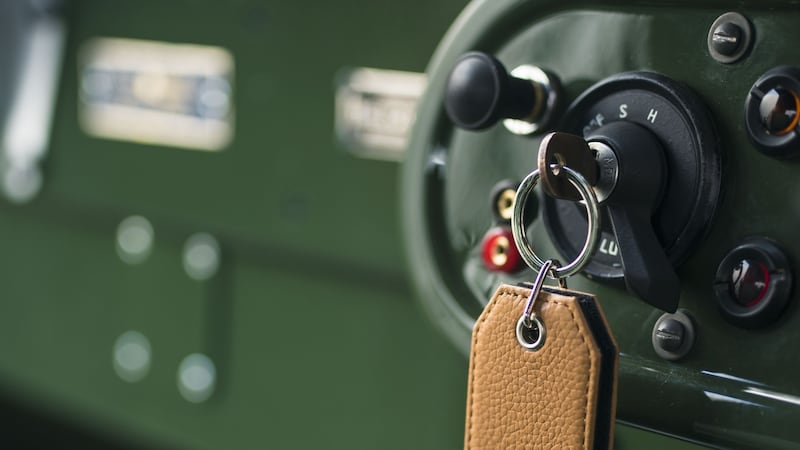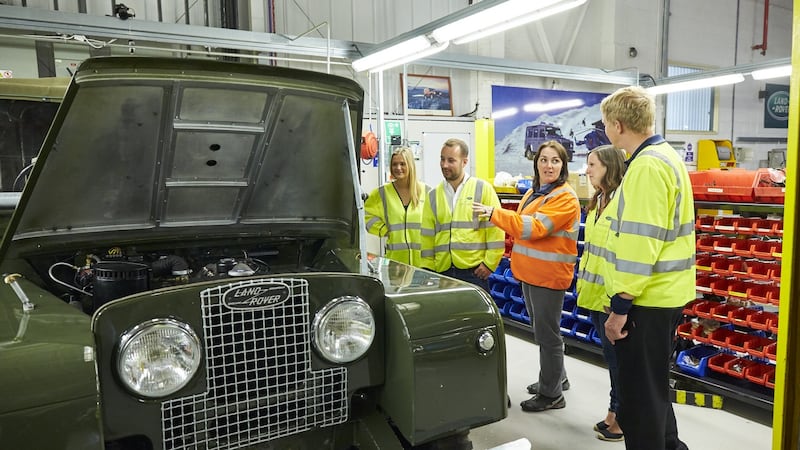Land Rover’s Classic division has confirmed that it will start building (or re-building, depending on your point of view) Series 1 Range Rovers, first built in 1970. The first Reborn example was shown off at the vast Retromobile classic car show in Paris last week. The cars will be built around original chassis, bodies and engines, but will be effectively new, built from original parts or those created from original drawings, in a process which takes time, patience and a frankly fanatical eye for detail. Prices for an as-new S1 Range Rover will start from around €150,000.
So how is this different to a normal classic car restoration? Well, hidden away in Land Rover’s sprawling Solihull factory site, around a corner once occupied by the famed ‘Jungle Track’ off-road course, still marked by a solitary, incongruous palm tree, there is a door. It’s a plain, grey door set into red brick, but it leads to a world of wonder, if you’re of a certain frame of mind when it comes to old Land Rovers.
Geriatric metal


There are things that you might expect to find when inspecting a car that was built in 1949. Rust, for one. Possibly a touch of mould on fabric parts. A lingering scent of ageing oil and geriatric metal. What you don’t expect is new car smell…
This is not a mere restoration project, however. This is not an enthusiast in a shed happily bolting repro parts to an old chassis that he found on eBay. This is something quite different, and distinctly expensive. This is Reborn. This is also not the first time we have seen such a car. Aston Martin started this idea in the nineties with the DB4 GT Zagato Sanction II cars - four original sixties coupes built by the factory, using original chassis numbers and sold for colossal sums. Aston is at it again now, with the recently-announced re-starting of DB4 GT coupe production (so to speak) at its historic Newport Pagnell factory. Jaguar too has been in on the game, re-creating, from scratch, such cars as the 'Lightweight' E-Type coupe and the XKSS road-racer for price tags running into seven figures.
Land Rover, as is so often the case with the brand, is doing things a little differently. For a start, the price being asked for a 'Reborn' Series I Land Rover is a fraction of that which Jaguar wants for one of its recreations. And it's not strictly a recreation either - Land Rover isn't remanufacturing these cars from the ground up, it's using original cars as donor vehicles, but neither is this traditional restoration. It's something different again, perhaps hence the phrase 'Reborn' - there is a sense of rebirth about the whole thing.
Parts bin
As an example, Greg King, Land Rover Reborn engineer, told The Irish Times about the minutiae of finding not just the correct parts for a Reborn car, but the correct parts in the correct format… "If we're making parts for Reborns, we might need 50 parts, but we can make more than we need to open the market up to Land Rover restorers, which is a longer term plan, but it's definitely something we can do. gradually you'll see the availability of parts growing, and if we're struggling to find a part here, then it must be a rare one, so it's the rarer or more difficult to source parts that we're thinking of introducing. Everything has to have a business case, but there are a number of parts we've had re-tooled, such as original specification exhausts" he said.
“The only Series I exhausts that were available were a pattern part, the didn’t fit very well , they were rolled rather than seam-edge welded. So it’s simple things like that which we can put back in to production, and make them available if a Series I customers wants a correct exhaust for their car then we can make that available.
“Other parts are things like pivot shafts for the clutches, which always wear because people didn’t grease them properly, even bolts that you can no longer get. It’s ‘well, we’ll just bolt that on. No, wait, we have to go an make the correct bolt first…’”
Sprawling site
Land Rover’s Solihull factory is a sprawling site, almost a city unto itself, despite the leafy suburban roads that lead to the main gate. Just beyond the security hutch, and in the lee of the huge original works building, which once made aircraft engines for Lancasters, Mosquitoes and Spitfires, is a fresh piece of semi-circular architecture, the sort that you might find in any technology park.
The fascinating bit is the cars, or more accurately the shelves that surround them. The most stripped-down cars, the ones which are currently just a rolling chassis, essentially live in boxes. These boxes contain all the useable parts stripped from the donor vehicle (Land Rover says that it has “been very particular to get as much original DNA as possible”) and carefully marked up for repair, restoration, respray and reuse.
Donor cars have to be found, leading Stuart Kilvington, Jaguar Land Rover Classic Sales Manager who hunts down the donor cars, to tell The Irish Times that "some of them have had things done to them over the years to keep them going and a lot of them are still working vehicles were owners have just used whatever was to hand to keep them going, so that's why a lot of potential donor cars are falling by the wayside for us at the moment. I went to see 30-odd in a field the other day, but there might only be one of those that might, possibly make the grade.
“That’s another really interesting side of it, the investigation. You’ll get a tip-off about a car and it’s almost like a private eye novel to go and find it. That side of things is fascinating. People come up to us at shows with “Oh, Bob had one of those…” But of course they were working machines originally, and maybe at one time not valued very much, they might have put it at the back of a shed and kept it and bought a new one. The problem is that some of those customers, they won’t sell those cars to us. It’s a case of ‘I’ve got one but I’ll never part with it…’ Those ones are almost the worst, but some do say that they’ll bring their cars to us to restore in a few years, which is obviously what we’re working towards. At the moment, buy doing our own, we can work to set a standard for the work and materials.”
Just 25 Reborns will be built, initially and they will only ever be made to original factory standard, although options such as leather seats and a second windscreen wiper, available on the original spec sheet, will be offered. The only concession to modernity is the fitment, as standard, of an electronic anti-theft system and tracking device.
What next? Well, customer demand is apparently there for more, and similar rebirths of Series II and Series III models has been discussed, although it’s uneconomical at present, thanks to the relatively lower values of those cars. Still, seeing as the Defender itself has seen a growth in values with the end of production, there can surely not be long left for that to be the case…
Community project
For all the talk of values, though, this is something of a community project. The cars will be sold for vast sums to wealthy collectors, but the whole world of Land Rover enthusiasts have lent their time and effort to the cause. “I’ve got two vehicles coming at the moment, from very different parts of the world, both of which other buyers had tried to purchase but which the owners called us and said ‘there’s only one right and proper place for my car to go. I want it to come back to the factory.’” said Kilvington. “They get a great feeling out of the thought that it’s going to live again, it’s very satisfying”
A price tag of €90,000 or thereabouts seems somewhat steep for a car which is already a grandparent, in age terms, but this is a burgeoning trend. For the same price as a well-specced Range Rover Sport, you can get in on what the Wall Street Journal calls ‘the new status symbol’ - an original, classic 4x4. And given the effect that the Reborn project has had on the values of good condition Series Is, expect this to be as gilt-edged a motoring investment as one can make.
















